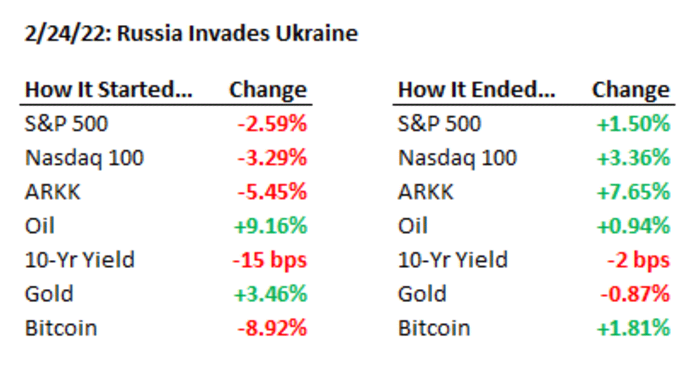This post was originally published on this site
Oil shocks aren’t what they used to be.
In 1990, the decision by Iraqi leader Saddam Hussein to invade Kuwait sent oil prices soaring, serving to further slow a U.S. economy headed into recession. On Thursday, crude prices briefly jumped back above the $100-a-barrel threshold for the first time in more than seven years after Russia’s Vladimir Putin ordered an invasion of Ukraine.
It may be another case of history rhyming rather than repeating. The 1990 oil shock further slowed a U.S. economy that had already tipped into recession and left stocks to flounder over the next six months before regaining their footing, noted Nancy Tengler, CEO and chief investment officer at Laffler Tengler Investments.
This time around, the economy doesn’t appear in danger of recession, but growth is slowing and the Federal Reserve may have already made a policy mistake by waiting too long to raise interest rates in the face of persistent inflation, she said, in an interview.
As for oil prices, they’ve become less of a worry over time: “The good news in all of this that we use our cars less. Because first of all, we have electric vehicles, people use ride hailing, but they also are working from home to a good extent and the total impact of oil on GDP, and even individual pocketbooks, is lower than it used to be,” she said.
Related: Ukraine invasion stokes stagflation worries because Russia is a ‘commodity superstore’
That means Tengler isn’t convinced by arguments that an oil or broader commodity shock is set to spark a bout of stagflation — the unpleasant combo of persistent inflation and sluggish, or stagnant, growth and high unemployment. And that brings us to the call of the day.
“We think this is a good time to be adding to holdings if you can, but not jumping in with both fists,” she said.
“We’re now for the first time in a period where technology capex is greater than 50%,” she said — a phenomenon that has a multiplier that will help companies deal with wage pressures.
“We’re more of the camp that growth is slowing. For the foreseeable future this year you still want to have exposure to some of these growth at a reasonable price names,” she said. “And then, when we get through the midcycle of the economy, which is where we think we are, we can think about becoming defensive.”
Meanwhile, war continues to rage in Ukraine, with Russian forces seen closing in on the capital Kyiv. Amid the carnage and human tragedy unleashed Thursday, financial markets witnessed some intense reversals, with U.S. equities rebounding from an initial decline to end the day higher, led by rate-sensitive tech stocks. At the closing bell, the Dow Jones Industrial Average
DJIA,
was up 0.3%, while the S&P 500
SPX,
erased a 2.6% fall to end 1.5% higher and the tech-heavy Nasdaq-100
NDX,
reversed a 3.3% decline to end 3.4% higher.
The chart below from Bespoke Investment Group lays out all of big intraday turnabouts:

Bespoke Investment Group
The buzz
Earnings from Foot Locker
FL,
Lending Tree
TREE,
Cinemark
CNK,
and Scripps
SSP,
were due Friday.
Among Thursday’s after-hours highlights, cryptocurrency exchange platform Coinbase Global Inc.
COIN,
crushed Wall Street expectations for its fourth quarter but cast doubt on current-quarter prospects. And, dude, you’re getting a dividend: shares of computer maker Dell Technologies Inc.
DELL,
were headed TK after earnings reported Thursday night fell short of Wall Street expectations, while the company’s board initiated a dividend, starting at 33 cents a share for the quarter.
And set some reading time aside this weekend for Warren Buffett’s yearly investor letter, which is expected to accompany Berkshire Hathaway Inc’s
BRK.A,
BRK.B,
annual report on Saturday.
A heavy lineup of data includes personal and consumer spending, the Fed’s favored core personal-consumption expenditures price index and durable goods orders ahead of the open. The University of Michigan consumer sentiment index and pending-home sales are due later.
The markets

Uncredited
U.S. stock futures
ES00,
NQ00,
were pointing to a slightly lower start after Thursday’s big bounce, with Treasury yields
TMUBMUSD10Y,
edging higher and oil prices
CL00,
BRN00,
back on the rise, while gold
GC00,
lost ground. Elsewhere, Asian markets mostly gained ground and European stocks
SXXP,
bounced higher.
The tickers
These were the top tickers on MarketWatch early Friday:
Random reads
‘Hard-partying bands are the outliers now’: how rock’n’roll broke up with booze and drugs
AI outraces human champs at the videogame Gran Turismo
Need to Know starts early and is updated until the opening bell, but sign up here to get it delivered once to your email box. The emailed version will be sent out at about 7:30 a.m. Eastern.
Want more for the day ahead? Sign up for The Barron’s Daily, a morning briefing for investors, including exclusive commentary from Barron’s and MarketWatch writers.


